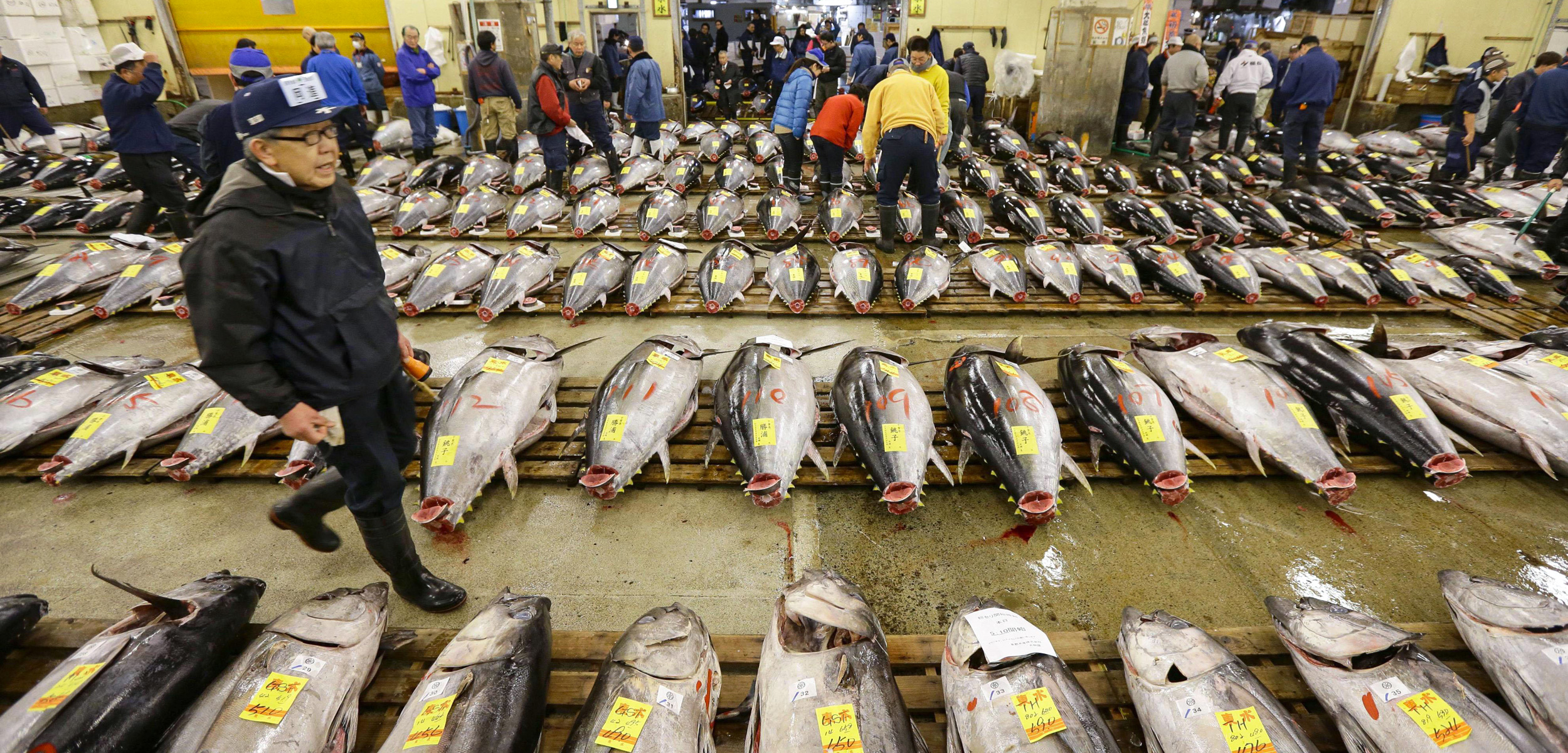Japan Has an Illegal Seafood Problem
Japan’s loose fisheries laws make it a destination for illegal, unreported, and unregulated seafood.
Article body copy
At 407,000 square meters, the world’s largest wholesale seafood market is in Tokyo, Japan. This comes as no surprise given that Japan is the world’s largest consumer of high-value fish, such as bluefin tuna, and the third largest seafood importer after the European Union and the United States. This voracity makes Japan vulnerable to importing large amounts of illegal, unreported, and unregulated (IUU) seafood, and according to a recently published study, its lax traceability requirements all but guarantee that illegal seafood has a market in the island nation.
In 2015, the year examined by the study, Japan imported an estimated US $1.6- to 2.4-billion worth of seafood caught from illegal and unreported sources. By weight, this estimate accounted for 24 to 36 percent of the country’s wild-caught seafood imports, placing Japan on the high end of the global average of 15 to 30 percent.
To reach this finding, researchers consulted more than 100 scientists, crew members, port agents, ship captains, distributors, and seafood auditors—all of whom were intimately tied to fisheries and supply chains. These confidential sources provided estimates of how much IUU product makes its way into Japan, data the researchers bolstered by visiting select ports and analyzing available import records.
Anastasia Telesetsky, an environmental lawyer at the University of Idaho whose work focuses on marine policy and who was not involved in the study, says she was not surprised by these findings, considering the marine species arriving in Japan’s ports. For instance, crabs from Russia have been associated with illegal fisheries for decades, according to the study. Even after Japan and Russia reached an agreement in 2014 to curtail IUU crab, the study shows that poached crab from Russia still made its way into Japan, albeit at a reduced level.
Although Japan imported a large amount of IUU product from Russian fisheries in 2015, the highest volumes originally came from China and the United States. As much as 55 percent of Chinese squid and cuttlefish came from illegal and unreported sources, as did 15 to 22 percent of Alaska pollock, a species commonly used in products like fish sticks.
Alaska pollock exemplifies the risks inherent in global supply chains, says Tony Pitcher, a fisheries scientist at the University of British Columbia and coauthor of the study. In fact, he says only two or three percent of Alaska pollock is caught illegally by US vessels. (Reaching zero percent, he says, is all but impossible for any fishery.) But that pollock goes to other countries, primarily China and Vietnam, for processing, where it gets mixed with illegally sourced pollock from Russia. That’s why, post-processing, Alaska pollock enters Japan with an elevated IUU content. Though the Russian fishery has made some improvements in recent years, Pitcher says it’s still in part controlled by criminal organizations operating unlawfully.
Telesetsky, whose work has explored the connection between organized crime and IUU fishing, says fish is a convenient commodity for laundering. “It’s really easy to hide,” she says, “because how can you tell if one tuna was caught legally and one was not? They look the same.” The lack of transparency at processing plants, as well as at other links in the supply chain, means that these sites are at risk of being targeted by illegal fishers, says Pitcher. “These loopholes are exploited by the people who are trying to launder their products.”
Pitcher attests that changes at processing plants, through which a significant portion of the world’s wild-caught seafood passes, can help address IUU fishing. “If the countries importing the seafood demand that they will only take things with catch documentation, then the processing factories will have to comply,” Pitcher says. And since these plants already abide by strict microbiological standards, the added regulation wouldn’t be onerous, he says.
In the past decade, the European Union and the United States have been working to close these loopholes by implementing stronger import measures. The United States’ 2018 Seafood Import Monitoring Program (SIMP), for instance, requires an importer to provide sufficient data such that a species at risk of being caught illegally can be traced back to its source.
And just last year, Japan significantly amended its fisheries laws for the first time in 70 years. The changes reflect a growing effort to protect overfished species in domestic waters by increasing penalties, imposing individual quotas on fishing vessels, and introducing a science-based total allowable catch system. Yet the country still lags behind the European Union and the United States when it comes to traceability standards, Pramŏd Ganapathiraju, a fisheries consultant and the study’s lead author, says in an email.
To effectively curtail IUU fishing at a global level, the top five seafood importers—the European Union, the United States, Japan, China, and South Korea—must require documentation for imported seafood across the entire supply chain, including at processing plants, Ganapathiraju says. Otherwise, it’s possible that “tight measures in one country divert IUU products to other countries where such verification measures are lacking,” he says, likening the upshot to the balloon effect—a term often used to describe the shifting patterns of drug traffickers, in which law enforcement squeezes them out of one area only for them to crop up somewhere else.
Japan may be on its way to matching the standards set by the European Union and the United States, however. Another piece of legislation may include traceability measures like those in SIMP. It would be another step toward reforming Japanese fisheries laws, and a necessary one, given that the country’s affinity for fish isn’t likely to go away. Last year, Tokyo’s iconic fish market moved across town from Tsukiji to Toyosu as the city prepares for the 2020 Olympics. The space is over one and a half times larger than the old location, and in its first auction, a single bluefin tuna sold for a record-breaking $3-million.

